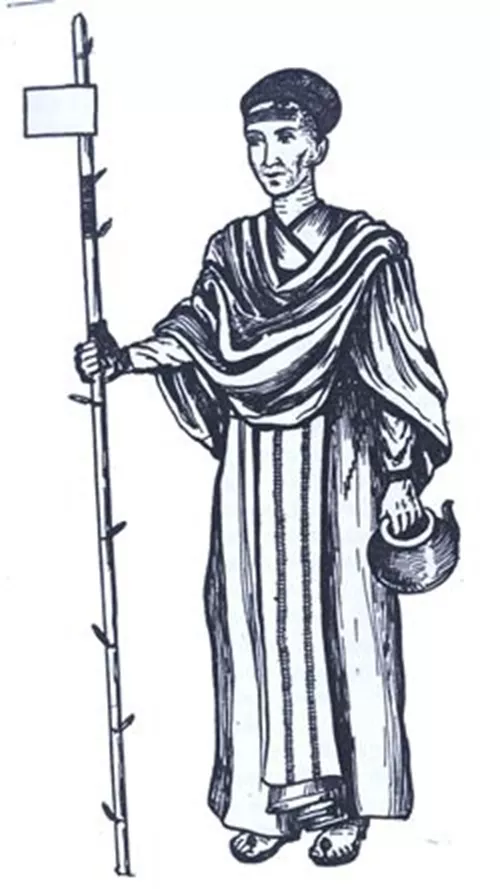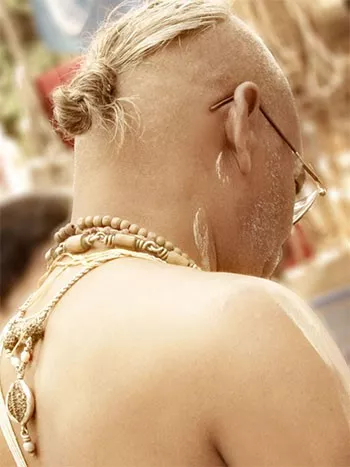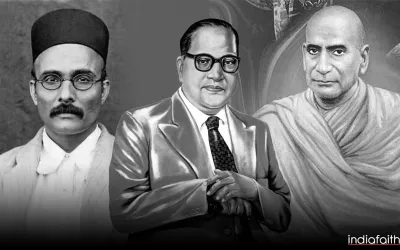The Jesuits induced many enthusiastic youngsters to the church to serve Christ and spread Christianity among heathens. St. Francis Xavier was the first missionary to arrive in Goa, whose sole ambition was to convert non-believers. The Portuguese missionaries who followed him continued the work from Kochi, Krangnur and Mylapur. However, Roberto De Nobili was the first Catholic ascetic who tried hard to understand the true Indian spirit. He tried to localise preaching and spread Christ's message. He endeared himself to the masses, by adopting Hindu customs.
Roberto De Nobili was born in Rome in 1577 A.D. and was related to the royal family. His father was a general of the Papal army, which fought the Turks during the crusades. Roberto was spiritually inclined at a very young and dreamt of working as a missionary in the East. He was inspired by the adventurous life of the missionaries in parts of Africa, Japan, and other eastern countries. Roberto received no encouragement at home and ran away to join the church. The Royal member was allotted all kinds of menial jobs in the Church. He did all menial jobs like scrubbing and washing vessels and helping in the kitchen. He also studied logic, science, theology, etc., and finally qualified himself to become a preceptor.
Roberto was then appointed for India. He reached Goa in 1605. The Jesuits were converting the Indians for more than 50 years now. However, he found that converted Goans were Christians only in name. Most of them came from very poor families and did not incline to lead a Christian life.
Malabar Rites
Later he went to Tamil Nadu and studied the local language and customs. He found the Jesuits were focused only on converting the poor class. The poor people would be converted by some allurements, incentives or threats. Roberto was convinced that converting only the poorest brought no credit to Christianity. He admired the Brahmins, who were very much respected in society. Roberto made his mission to convert the Brahmins so that Christianity would be better spread. Roberto noticed many similarities between the Hindu and Christian monks. Only the dress was different. To make himself more acceptable to the locals he started wearing ochre-robes, wooden shoes. He gave up meat and carried danda (stick) and kamandalu (water jug) like a Hindu monk. He started wearing Gandha (Sandal paste) and shaved his head.
He hired a Brahmin cook, restricted his diet to rice and vegetables, and began sleeping on the floor. In addition to penning Christian psalms and prayers in Tamil, he spent time studying Sanskrit and sacred writings. Opened a catechism school and gradually began to include Christian doctrine. Locals began to revere him as a "Iyer" (preceptor) because of his austere lifestyle, pleasant manners, and modestly acquired healing talents. There was lots of opposition among Christians about the mode of living and preaching Roberto had adopted. The complaints reached the papal authority. A secret enquiry was instituted by the church. But by now Nobili had converted a good number of people (more than 100) to Christianity. He had built a church modelled on a Hindu temple and had a very good following among natives. The converted Brahmins were allowed to wear sacred thread with a cross and continue with a tuft. This prompted others who wanted to gain a soft entry to Christianity.
De Nobili's approach to enculturation, which then seemed radical and downright revolutionary, consisted in adapting Christianity to the Indian context by adopting indigenous rites and customs as far as possible without conceding any fundamental Christian truth or principle. Instead of forcing Indians to become Europeans, the missionaries would try to adjust their way of life and preach to existing Indian cultural heritage and social conventions. His methods were called Malabar rites. Nobilis ideas triumphed and soon the Jesuits converted many Indians to Christianity. Nobili and his ilk deceived the Hindus to be pious and austere Sadhus. They fooled the people by introducing Christianity in the form of Hindu verses and language. The churches were made to look like temples, all Hindu rituals were incorporated in the Church-Temple.
Nobilis Literature
De' Nobili translated into Sanskrit or composed therein many prayers and several longer works, especially an abridgement of Christian Doctrine and a life of Our Lady, in Sanskrit verse. These were all in mani-pravala style with lots of Sanskrit words. Nearly all these productions were lost during his imprisonment in Madura (1639-41).
Some of his publications are:
(http://indianchristianwritings.blogspot.com/2009/07/roberto-de-nobili-sj-1577-1656.html)
Gnanopadesa Kandam I. – IV (Big Catechism I – IV ).
Punar Janma Akshepam. (Refutation of Transmigration.)
Nittiya Jivana Sallabam. (Dialogue on Eternal Life.) +
Devamatha Sarithiram (Life of Our Lady)
Thushana Dikkaram (Refutation of Calumnies)
Attama Nirnayam (Science of the Soul)
Mathasampanda Sallapam: un mathamanna? (What is your Religion?)
Preaching Wisdom to the Wise Three Treatises
And many others.
The Church and its representatives used Brahmins to deceive and convert natives in the 1600s and 1700s. Later the Brahmin community refused to convert and were vilified. It inspired an entire movement for their ouster led in the 1960s under the leadership of Periyar. To this date, ‘Brahminism’ is used as a derogatory slur. Brahmins are still hounded for the evils of society. A Cuckoo deed indeed. Instead of giving the Hindus Christian doctrine, with his superstitious inventions, he led the credulous minds of the Hindus into error and deception. The traditions and customs of the Hindus were derided. The authority structure was eroded, so as to enable the Christians to brainwash the locals.
This is how even the Christians felt about Nobili. Max Mueller said - "A man who could quote from Manu, from the Puranas, nay from the works such as the Apasthamba Sutras, which are known even at present only to those few scholars who can read Sanskrit manuscripts, must have been far advanced in the knowledge of the sacred language and the literature of the Brahmins." But many others contend that he learnt just enough to dazzle, not ever to exude in-depth. He could not understand the depth of knowledge of the Hindu scriptures.
The Fifth Veda
But the worst was yet to be revealed. Nobili inspired and maybe prepared the Fifth Veda or the Yesur Veda. This was presented to the Hindus as the lost Vedas. This forgery was so skilful that most Brahmins took it to be the original one. Even Voltaire went on to translate it to L’Ezour Vedam. Andrew Steinmetz in his book ‘History of the Jesuits Vol II’ says – So skilfully was the fifth Veda or Yesur Veda prepared, written in the same style as the first four that many Brahmins received it as authentic and Voltaire went on to translate it.
Final Act
By 1645 Nobili went blind. He spent two years in Jaffna, Ceylon as the Jesuit superior. Then he lived in Mysore until his death in 1656 at the age of 79. Roberto de Nobili died in Mylapore near Chennai in Tamil Nadu on 16 January 1656. He was 79. The common Christians in the coming years paid back his deceit, by adopting more and more Hindu beliefs. The breaking of the glass ceiling at the Vatican will be the final wreath to this deceitful Cuckoo. The Cuckoo bird lays its eggs in the crow's nest after kicking out the original ones. The Cuckoo eggs and offspring look similar to the Crow. The crow dutifully hatches and raises the young Cuckoos as its own. Deceit is painful and the Church sent such a deceitful Cuckoo to India.





Comments
Add new comment